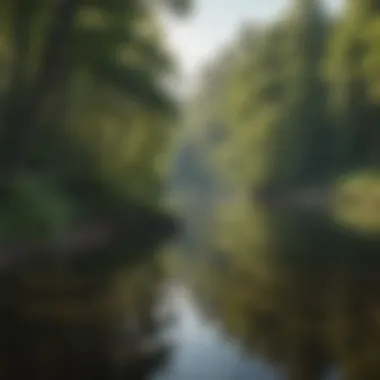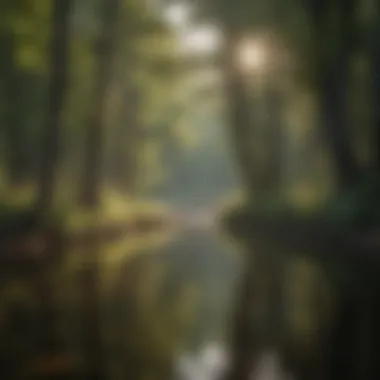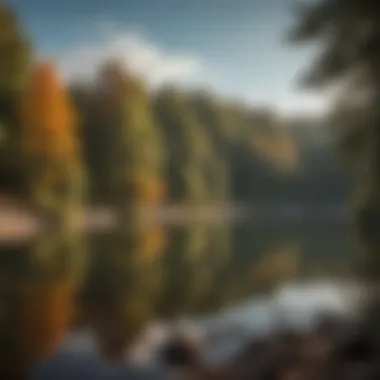Exploring Fool Hollow Lake Recreation Area: A Comprehensive Guide


Intro
Fool Hollow Lake Recreation Area stands out as a unique destination, offering a variety of outdoor activities and stunning scenery. This guide will delve into the multifaceted nature of the area, highlighting its ecological significance and recreational opportunities. It is essential for both professionals in ecology and casual nature enthusiasts to understand the intricacies of this region. Through this exploration, we aim to foster an appreciation for responsible interaction with natural resources while promoting conservation efforts.
Understanding Woodland Ecosystems
Woodland ecosystems are vital components of our environment. They provide numerous services that support both biodiversity and human well-being. These ecosystems possess rich flora and fauna which contribute to a balanced ecological system.
Importance of Biodiversity in Forests
Biodiversity in forests plays a crucial role in sustaining the environment. Diverse species promote resilience against diseases and climate changes. A variety of plants and animals ensures that the ecosystem remains stable. The more diversity present, the more functions the ecosystem can perform, from nutrient cycling to habitat provision.
Role of Forests in Climate Regulation
Forests act as carbon sinks, absorbing carbon dioxide from the atmosphere. This process is critical for climate regulation. They also help in maintaining local temperatures and humidity levels. The loss of forests would disrupt these natural processes, leading to more extreme weather conditions and contributing to climate change.
Sustainable Forestry Practices
For the sustained health of woodland ecosystems, sustainable forestry practices are necessary. These methods aim to balance ecological needs with the demands of human activity.
Principles of Sustainable Forestry
Sustainable forestry principles include:
- Maintaining forest health and biodiversity.
- Protecting soil and water resources.
- Ensuring economic viability for communities.
- Engaging local communities in decision-making.
By adhering to these principles, forestry operations can minimize their ecological impact while maintaining productivity.
Case Studies of Successful Implementations
Numerous examples demonstrate the success of sustainable forestry. Initiatives in countries such as Finland and Canada have showcased the benefits of managing forests responsibly. These countries focus on long-term environmental health while still providing wood products and recreational opportunities.
Woodland Stewardship Techniques
Stewardship techniques are essential in managing forests effectively. They integrate various approaches to ensure that woodland areas remain vibrant and sustainable.
Forest Management Plans
A well-designed forest management plan outlines the strategies for maintaining and benefiting from forest resources. It provides clear guidelines for:
- Harvesting timber responsibly.
- Protecting wildlife habitats.
- Mitigating fire risks.
Developing and following these management plans promotes both health and usability of forests.
Conservation Strategies
Conservation strategies in woodland areas focus on protecting biodiversity and ecosystem services. Strategies may include:
- Establishing protected areas to conserve critical habitats.
- Implementing restoration projects for degraded lands.
- Educating the public on the importance of conservation efforts.
These tactics ensure that woodlands continue to thrive for future generations.
Effective management and stewardship of woodland ecosystems depend on informed choices and responsible actions.
Prelims to Fool Hollow Lake Recreation Area
Fool Hollow Lake Recreation Area stands as a testament to the rich interplay between natural landscapes and recreational activities. The area is a hub for myriad outdoor pursuits, drawing attention from individuals who seek solace in nature and adventure in equal measure. It serves not only as a destination for relaxation but also as an intricate ecosystem that supports diverse flora and fauna.


Understanding the significance of this area requires an appreciation of its multifaceted offerings. Visitors can engage in activities such as camping, fishing, and hiking, making the site adaptable to various interests and preferences. This adaptability leads to a broader ecological awareness among visitors, which is vital, especially in today's context of environmental conservation.
Moreover, Fool Hollow Lake is not simply a recreational site; it plays a pivotal role in the local ecosystem. The lake and its surrounding areas provide critical habitats for numerous species, many of which are endemic to the region. This aspect elevates the lake’s importance beyond mere leisure. It becomes a focal point for biodiversity and a case study in ecological balance.
The management of Fool Hollow Lake Recreation Area is crucial. With increasing visitor numbers, the need for responsible usage and conservation is more evident. Understanding how to navigate these demands while preserving the area's natural beauty is essential. Engaging with the park's guidelines helps ensure that both visitors and the ecosystem can thrive together.
In summary, Fool Hollow Lake Recreation Area is significant due to its recreational, ecological, and stewardship aspects. As this article unfolds, it will delve deeper into these themes, exploring geographical contexts, biodiversity, and the conservation efforts that make this area truly remarkable.
Geographical Overview
Understanding the geographical context of Fool Hollow Lake Recreation Area enhances one's appreciation for its unique features and offerings. This section aims to provide an in-depth view of the location, accessibility, and the physical characteristics of this natural haven. The geographical overview provides practical information on how to reach the area and outlines the environmental context, which is key for outdoor enthusiasts and professionals alike.
Location and Accessibility
Fool Hollow Lake Recreation Area is located in the beautiful northeastern region of Arizona, near the city of Show Low. The area is easily reachable through a network of highways. Highway 260 and Highway 60 serve as the primary access points. Visitors coming from Phoenix can expect a scenic drive of approximately three hours, while those from Flagstaff may take slightly shorter routes.
Once in Show Low, local signs guide visitors to the recreation area. Ample parking is available for vehicles, making it an accessible destination for families, hikers, and anyone looking to enjoy nature. Public transport options are limited, so most visitors prefer personal vehicles or rental cars.
Topography and Climate
The topography around Fool Hollow Lake is diverse. The area features a mix of rolling hills, dense forests, and open clearings. Elevations vary, with the lake sitting at an altitude of about 6,400 feet. The water body itself sprawls across 150 acres, providing a picturesque landscape surrounded by tall pines and native vegetation. This varied terrain presents different recreational opportunities, from hiking to canoeing.
Understanding the climate is also essential for planning a visit. Fool Hollow Lake experiences a distinct four-season climate. Summers can be warm, with temperatures averaging in the mid-80s Fahrenheit. However, the altitude ensures that evenings are cooler. Winters can be quite cold, with temperatures dropping below freezing at times. Snow is common, especially in December and January. Consequently, the best times to visit are generally spring and fall when temperatures are more moderate and the foliage is vibrant.
In summary, the geographical overview of Fool Hollow Lake Recreation Area illustrates not just the natural beauty but also the practical considerations for accessing and enjoying this outdoor treasure. Grasping these factors significantly enriches the experience for both casual visitors and seasoned professionals.
Ecological Significance
The Ecological Significance of Fool Hollow Lake Recreation Area extends beyond its visual allure. This area plays a vital role in supporting diverse ecosystems and promoting environmental health. The combination of its rich biodiversity and critical habitats contributes to the overall ecological balance. Understanding these aspects is crucial, not only for fostering appreciation among visitors but also for guiding conservation efforts.
Biodiversity in Fool Hollow
Fool Hollow Lake Recreation Area is home to an array of species, both flora and fauna. This biodiversity is important for several reasons. A variety of species insures ecological resilience. When a habitat is diverse, it is better equipped to withstand environmental stresses such as climate change or invasive species.
Some key highlights include:
- Flora: Different plant species provide food and shelter for wildlife. Various trees and shrubs in the area contribute to the unique landscape.
- Fauna: Numerous animals, including birds, mammals, and amphibians, can be observed. This diversity enriches the recreational experience and contributes to ecological stability.
Additionally, the unique species found here often serve as indicators of environmental health. Protecting this biodiversity is essential for preserving the area's ecosystem and ensuring it continues to thrive for future generations.
Critical Habitat Areas
The recreation area contains several critical habitat areas that are essential for preserving its ecological integrity. These zones often serve as breeding grounds or migratory paths for various wildlife species. Protecting these habitats is crucial for not only the survival of individual species but also for maintaining the area’s biodiversity as a whole.
Key considerations include:
- Wetlands: These areas provide essential services, such as water purification and flood control. They also support a variety of aquatic and bird species.
- Forested areas: The mature forests serve as home to numerous mammals and birds. These zones help in carbon sequestration, benefiting global climate initiatives.
- Open spaces: Such environments support pollinators and contribute to ecosystem functions such as seed dispersal.
"Conservation of critical habitat areas is crucial for the sustainability of ecosystems within Fool Hollow Lake Recreation Area."
Recreational Opportunities
Fool Hollow Lake Recreation Area offers a wide range of recreational activities that cater to diverse interests. The area's natural setting not only provides aesthetic pleasure but also serves as a backdrop for active pursuits. Engaging in these activities contributes significantly to the overall visitor experience and well-being. Whether one seeks relaxation or adventure, the recreational opportunities here invite exploration and connection with nature.
Camping Facilities
Camping at Fool Hollow is a key attraction. The facilities provided are designed for comfort and convenience. Campers can choose from numerous sites equipped with picnic tables and fire rings. Some areas offer electric hookups. This variety makes it accessible for both tent campers and those with RVs.
Moreover, modern restrooms and shower facilities enhance the camping experience. Being surrounded by the natural landscape brings a sense of tranquility, allowing campers to unwind. Proximity to the lake facilitates easy access to recreational water activities, making camping here an appealing choice.


Fishing and Water Activities
Fishing is a popular activity in Fool Hollow Lake. With an array of species, including trout and bass, anglers find rich opportunities to engage in this time-honored pursuit. The lake's well-maintained fishing areas ensure a productive outing.
In addition to fishing, visitors can indulge in other water activities such as kayaking and canoeing. Paddling along the scenic shores offers an immersive way to appreciate the area's beauty. Rental options are also available for those who may not bring their own equipment, eliminating barriers for participation.
Hiking Trails
The hiking trails at Fool Hollow Lake are another notable feature. These trails vary in difficulty, accommodating both novice and expert hikers. Some paths meander gently along the lake, while others lead into the surrounding woodland areas. This diversity ensures pleasant views and encounters with the local flora and fauna.
Trail maps are often available at the entrance. These help visitors plan their adventure while allowing them to discover hidden spots. Hiking promotes physical well-being and connects visitors deeper to the ecosystem.
Wildlife Observation
Wildlife observation adds depth to the recreational experience. The region is home to a variety of mammals, birds, and other creatures. Observing species in their natural habitat can be deeply rewarding. Many trails and observation points are specifically designated for this purpose.
Birdwatchers, in particular, encounter extensive diversity. Species range from hummingbirds to woodpeckers, making Fool Hollow a favored location for avian enthusiasts. Appropriate viewing tools can enhance the experience, making it easier to spot and identify different animals.
In summary, the recreational opportunities in Fool Hollow Lake Recreation Area are vast. Each activity offers unique benefits, from enhancing physical health to fostering a connection with nature. Visitors are encouraged to take full advantage of these offerings.
Visitor Information
Understanding the visitor information related to Fool Hollow Lake Recreation Area is crucial for anyone planning a trip there. This area attracts many nature lovers and outdoor adventurers each year, and knowing the basic logistical details can enhance the overall experience. Key components such as hours of operation, entrance fees, permits, and safety guidelines all contribute to an informed visit. Familiarity with these elements allows visitors to maximize their time in the area and engage in its offerings responsibly.
Hours of Operation
Fool Hollow Lake Recreation Area is typically open year-round, with slight variations depending on the season. Visitors are encouraged to verify the specific hours during their planned visit. Generally, the area opens at dawn and closes at dusk. This schedule helps match the natural activities of wildlife and ensures the safety of all guests. Additionally, understanding these hours can prevent disappointments and allow for better planning of activities like hiking or fishing.
Entrance Fees and Permits
Access to Fool Hollow Lake often requires entrance fees, which contribute to maintaining and improving the recreational facilities. Current fees for vehicles entering the park should be checked prior to arrival, as these may include options for day-use pass or annual passes. Comparatively, permits may be required for certain activities, such as fishing or camping. It is wise to acquire all necessary permits ahead of time to prevent any interruptions during your visit.
Safety Guidelines
Safety is paramount in outdoor recreational areas such as Fool Hollow Lake. Each visitor should be aware of and adhere to specific guidelines designed to protect both themself and the wildlife. Some key safety tips include:
- Staying on marked trails to preserve natural habitats
- Keeping a safe distance from wildlife to minimize stress on animals
- Following fire safety protocols when using grills or campfires
- Carrying sufficient water and supplies during hikes
- Being mindful of weather conditions and preparing accordingly
By following these guidelines, visitors ensure a safer experience for themselves and help maintain the ecological integrity of Fool Hollow Lake.
Important Note: Always remember to check local regulations and guidelines, as they can change based on natural events or management decisions.
Conservation Efforts in the Area
Conservation efforts at Fool Hollow Lake Recreation Area are crucial for maintaining the ecological balance and health of the region. These initiatives not only protect the diverse flora and fauna but also enhance the recreational experience for visitors. Understanding these efforts is essential for everyone who values nature and wishes to enjoy it responsibly.
The area is experiencing various environmental pressures, from invasive species to climate change impacts. By highlighting conservation projects, one can appreciate the importance of stewardship in sustaining the natural beauty of Fool Hollow Lake for future generations.
Restoration Projects
Restoration projects play a significant role in addressing the environmental issues present in Fool Hollow Lake Recreation Area. These projects include reforestation efforts, wetland restoration, and the rehabilitation of disturbed sites.
Efforts are made to remove invasive plants that threaten local wildlife. For instance, certain non-native species can outcompete indigenous plants, which serve as essential habitats for various birds and mammals.
By restoring native vegetation, wildlife populations can thrive better, reflecting a positive trend in biodiversity.
Furthermore, erosion control measures help protect waterways from sedimentation. This is crucial to maintaining water quality within the lake, which supports fish populations and recreational activities such as fishing and kayaking.


Continued restoration is vital for preserving the ecological integrity of Fool Hollow Lake.
Community Engagement and Volunteering
Community engagement and volunteering initiatives are vital components of conservation efforts at Fool Hollow Lake Recreation Area. Local organizations often lead activities like clean-up events, tree planting days, and educational workshops.
Involving residents and visitors fosters a sense of ownership and responsibility towards the area’s natural resources. Volunteers contribute their time and skills, helping to augment the efforts of professional conservationists. In return, they gain valuable insights into ecological practices and the importance of sustainability.
Participation in these initiatives often leads to increased environmental awareness among the community, promoting a culture of conservation. Several online platforms, such as Facebook and forums like Reddit, provide information about upcoming events and opportunities for individuals looking to get involved.
Ultimately, the synergy between conservation projects and community involvement underscores the commitment to protecting Fool Hollow Lake Recreation Area’s rich ecological heritage.
Cultural and Historical Context
The exploration of Fool Hollow Lake Recreation Area necessitates a discussion about its cultural and historical context. Understanding this aspect is essential not only for appreciating the area’s natural beauty but also for recognizing the layers of human interaction with this landscape. The region is rich in indigenous history and offers insight into past settlements. This dual focus on culture and history grounds the visitor's experience, making every visit more meaningful.
Indigenous Heritage
The heritage of the indigenous peoples who originally inhabited this area is a significant part of Fool Hollow Lake Recreation Area's identity. This land was once a vital site for various tribes, providing them with resources and spiritual connection. Archeological evidence suggests that the area was likely used for fishing and gathering, showcasing the sustainable practices of these communities.
Oral traditions among native tribes highlight their deep reverence for the natural world. Stories passed through generations often emphasize the importance of environmental stewardship, a value still relevant today. It is crucial for visitors to understand this context as it fosters respect for the land. Learning about the historical practices and beliefs of the indigenous peoples can enhance one's appreciation of the surrounding ecosystems.
Historical Significance of the Area
Fool Hollow Lake is not just a natural wonder; it carries historical significance which unfolds over time. The area has transitioned from being a vital resource for indigenous communities to becoming a place of recreation and tourism. Historical records indicate that during the late 19th century, European settlers began to establish their presence in the region. Their arrival altered the land-use patterns and the ecological balance.
Over the years, the area has served multiple purposes: from agricultural lands to a recreation site designated to promote wildlife conservation and public enjoyment. The adaptive reuse of this space speaks to the changing needs of society while highlighting the importance of preserving natural settings.
Preservation efforts today consider cultural heritage as well as environmental impacts. Understanding the historical layers now enhances the visitor experience, providing important context to the natural beauty of Fool Hollow Lake. Experts suggest that continued education about this historical tapestry remains vital for responsible tourism and conservation.
"Knowledge of a place’s history can profoundly enhance the experience of those who visit it, transforming mere observation into appreciation."
Future of Fool Hollow Lake Recreation Area
The future of Fool Hollow Lake Recreation Area holds significant implications for both the natural environment and the local community. As interest in outdoor recreation continues to grow, planning for future developments and sustainable practices becomes increasingly critical. This section delves into the initiatives and considerations that will shape the future of this valuable resource, ensuring that its ecological integrity is preserved while enhancing recreational opportunities for visitors.
Planned Developments
Future developments in Fool Hollow Lake Recreation Area are designed to improve visitor infrastructure while prioritizing environmental conservation. Planned projects include the construction of enhanced visitor centers, improved trail systems, and updated camping facilities. These developments aim to make the area more accessible and informative for visitors.
- Visitor Centers: A new visitor center will provide educational resources on the local ecosystem and recreational offerings.
- Trail Upgrades: The park will see an expansion of hiking trails. This will allow for better exploration of the area while reducing overcrowding on existing paths.
- Camping Facilities: Expanding and enhancing camping facilities will support more visitors and promote longer stays.
These plans consider the delicate balance between human activity and nature, ensuring that new structures do not disrupt wildlife or habitats. Engaging local stakeholders throughout the planning process will further help find common ground between development and preservation.
Sustainable Practices Moving Forward
As the Fool Hollow Lake Recreation Area looks toward the future, integrating sustainable practices into all aspects of park management is essential. These practices not only benefit the environment but also enrich the visitor experience.
- Habitat Restoration: Initiatives to restore original habitats will focus on reintroducing native plants and reducing invasive species.
- Waste Management: Implementing enhanced waste management strategies can reduce litter and maintain the park's natural beauty. This may involve more recycling stations and educational campaigns on responsible waste disposal.
- Water Conservation: Efficient water usage strategies will be crucial, especially in light of changing climate dynamics. This includes using native drought-resistant plants in landscaping.
"Engaging the community and fostering environmental stewardship is key to the sustainability of Fool Hollow Lake Recreation Area."
Incorporating these sustainable methods will ensure that the park continues to serve as a sanctuary for wildlife, while also offering a fulfilling experience for visitors. By prioritizing these practices, the area can maintain its ecological health and provide future generations with the opportunity to connect with nature.
The End
Fool Hollow Lake Recreation Area emerges as a pivotal location that intertwines natural allure with recreational activities. Its significance is threefold: ecological, recreational, and educational. For forestry professionals and academics, this site exemplifies how a natural ecosystem can be both preserved and utilized for outdoor recreation.
From an ecological standpoint, Fool Hollow Lake offers diverse habitats that cater to numerous species. This biodiversity not only enriches the environment but also provides crucial insights into ecological interactions. Understanding these dynamics is essential for effective conservation efforts.
Recreationally, the area serves various interests—camping, fishing, and hiking, among others. These opportunities promote physical wellbeing and foster a connection with nature. As outdoor activities increase, it becomes vital to balance utilization with sustainability, ensuring the preservation of this natural resource.
Moreover, educational aspects shine through in the community's engagement and volunteer programs. Involving locals fosters a sense of stewardship, essential for long-term conservation goals.
The thoughtful integration of recreation and conservation efforts is a model for similar areas aiming to balance human activity with nature.







